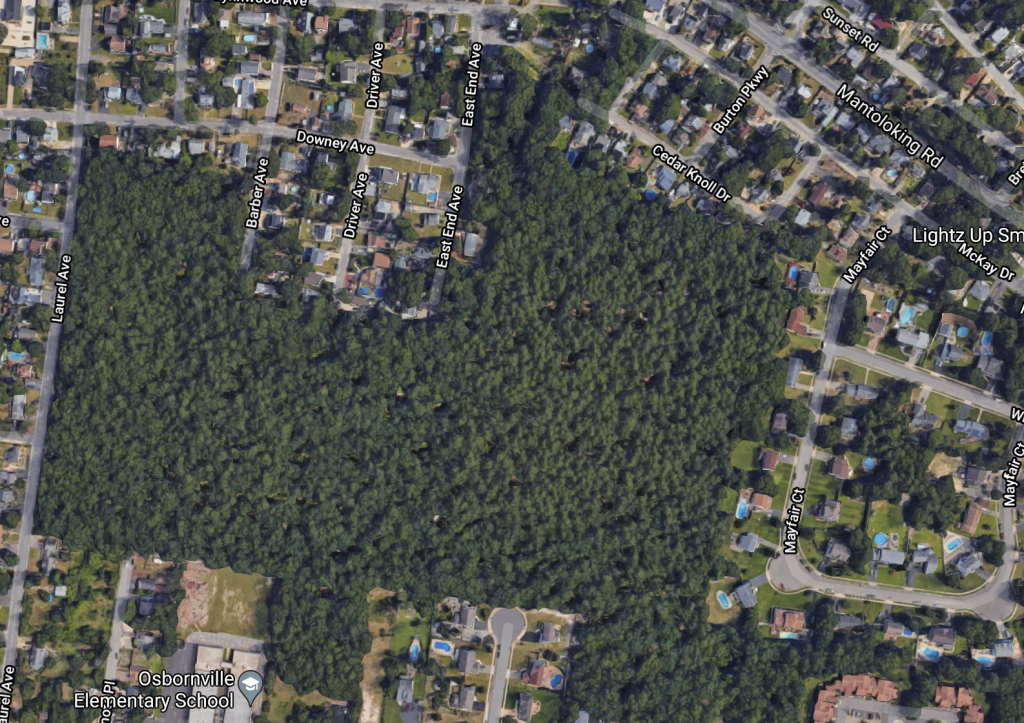
A property owned by the Church of Visitation that may be slated for residential development. (Credit: Google Maps)
A developer is interested in building dozens of homes – as many as 60 in all – on a parcel of land owned by Visitation Roman Catholic Church that was once proposed as a cemetery.
Residents within 200-feet of the 34-acre property were notified over the past week that a homebuilder, D.R. Horton, has applied to the Department of Environmental Protection to begin the process of determining the breadth of wetlands on the parcel to confirm whether or not a project is feasible in the area. The developer has not applied to the township’s planning or zoning boards seeking to develop the lot – only to the state on the wetlands issue. The property is located off Laurel Drive.
It is likely the developer will face an uphill battle, not only given public sentiment that is sure to prompt legal objections, but township ordinances that would likely force D.R. Horton to obtain a use variance to build homes on the property. Use variances require a supermajority vote of the planning board and are considered the most difficult to obtain under the state’s Municipal Land Use Law and court precedents.
|
|
The lot, which according to county tax records is still owned by the church, was last the subject of development rumors in 2013. Representatives from the Diocese of Trenton indicated that the church was interested in utilizing the land for a cemetery, but the project was ultimately abandoned. The last official action taken by the planning board was the approval in March 2013 of a reverse subdivision request that converted three separates lots into two. At that hearing, which encompassed the total area of the parcel, the board approved the creation of one 10-acres lot and one 24-acre lot.
Residents were served with notifications around the same time that the church was planning a 7,000 plot cemetery at the site. David Roskos, an attorney for the diocese, told board members that any development at the site would be “religious based.”
At the time, Roskos openly warned residents who attended the meeting that if they opposed the cemetery plan, the site could be sold to a real estate developer.
“If the church sold this to a builder, and the builder came in to build houses, he could put lots in next to the existing lots that are there. You would not have trees and you would not have a buffer,” Roskos said at the time. “I understand there are concerns here; we’re trying to be sensitive to the local neighborhood while we develop our religious uses.”
Indeed, the focus of development of the lot has shifted to a residential use. The subject lot of the state determination request (Lot 21 of Block 646) is located in the R15 zone, which requires 15,000 square foot properties to be developed with single-family homes.
Even if the developer is successful in obtaining DEP approval for the project, township officials have said there are other statutes and ordinances that would apply to a potential application for development of a residential community.
First, the state’s Coastal Areas Facilities Review Act limits impervious coverage – portions of the property physically covered by a building or hard surface, such as a driveway or patio – to 30 percent of the total land area. On top of that requirement, a local ordinance only allows developers to count land that is not portions of wetlands or buffers toward the total allowable area for construction.
“They will need a use variance because it exceeds what is used in the zone,” Mayor John Ducey said this week.
Elected officials are generally precluded from offering personal opinions on potential development projects, as any input – whether for or against a proposal – can be construed by a court as an undue influence applied on a planning or zoning board. Attorneys, in the past, have used such statements in quests to overturn board decisions and have been successful in doing so.
Ducey confirmed only that no development application had been made to the township and various ordinances would apply if an application is made.
“They have to go to the DEP and then they have all sorts of pitfalls in terms of wetlands and impervious coverage before they would be able to do anything out there,” he said.

Advertisement

Police, Fire & Courts
South Toms River Man Charged in Violent Murder of Wife

Police, Fire & Courts
Toms River Man, 36, Charged With Failing to Register Under Megan’s Law









